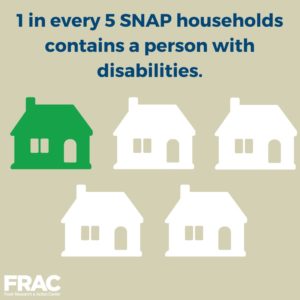Americans living with disabilities face many obstacles in their everyday lives, including higher than average rates of unemployment, lower than average incomes, and costly medical expenses.
On top of these obstacles, food insecurity disproportionately affects people with disabilities. In 2009-2010, households with adults living with disabilities experienced a food insecurity rate of 33 percent — almost three times the rate at which households with no adults with disabilities were food insecure (12 percent).
The problem of food insecurity among households with people with disabilities would be far worse if not for the Supplemental Nutrition Assistance Program (SNAP, formerly known as food stamps). In an average month in 2015 (pdf), SNAP served an estimated 4.5 million households that included a person with a disability — 1 in 5 of all SNAP households.
Still, many eligible households with people with disabilities are not receiving SNAP. FRAC’s new resource, Best Practices for Improving Access to SNAP for People With Disabilities, highlights ways that state agencies and anti-hunger advocates can maximize SNAP’s supports for people with disabilities. Here are five key strategies to close gaps in SNAP participation under current federal rules:
•Provide information and application assistance in partnership with organizations that are led by — and serve — people with disabilities.
•Use special rules available to help people with disabilities receive SNAP benefits for as long as they are in need. For example, states can allow longer certification periods (24 months instead of 12 months).
•Help people with disabilities receive the full amount of SNAP benefits for which they qualify by simplifying the process by taking into account the excess out-of-pocket medical expenses they incur, which can result in higher SNAP benefits.
•Coordinate between the Social Security Administration (SSA) and state SNAP agencies to seamlessly enroll Supplemental Security Income (SSI) recipients in SNAP through data matching and information sharing.
•Allow persons with disabilities to use their SNAP benefits to purchase meals at authorized restaurants that offer low-cost options.
For more information, check out FRAC’s Best Practices for Improving Access to SNAP for People With Disabilities, and search the hashtag #ThisIsSnap.


